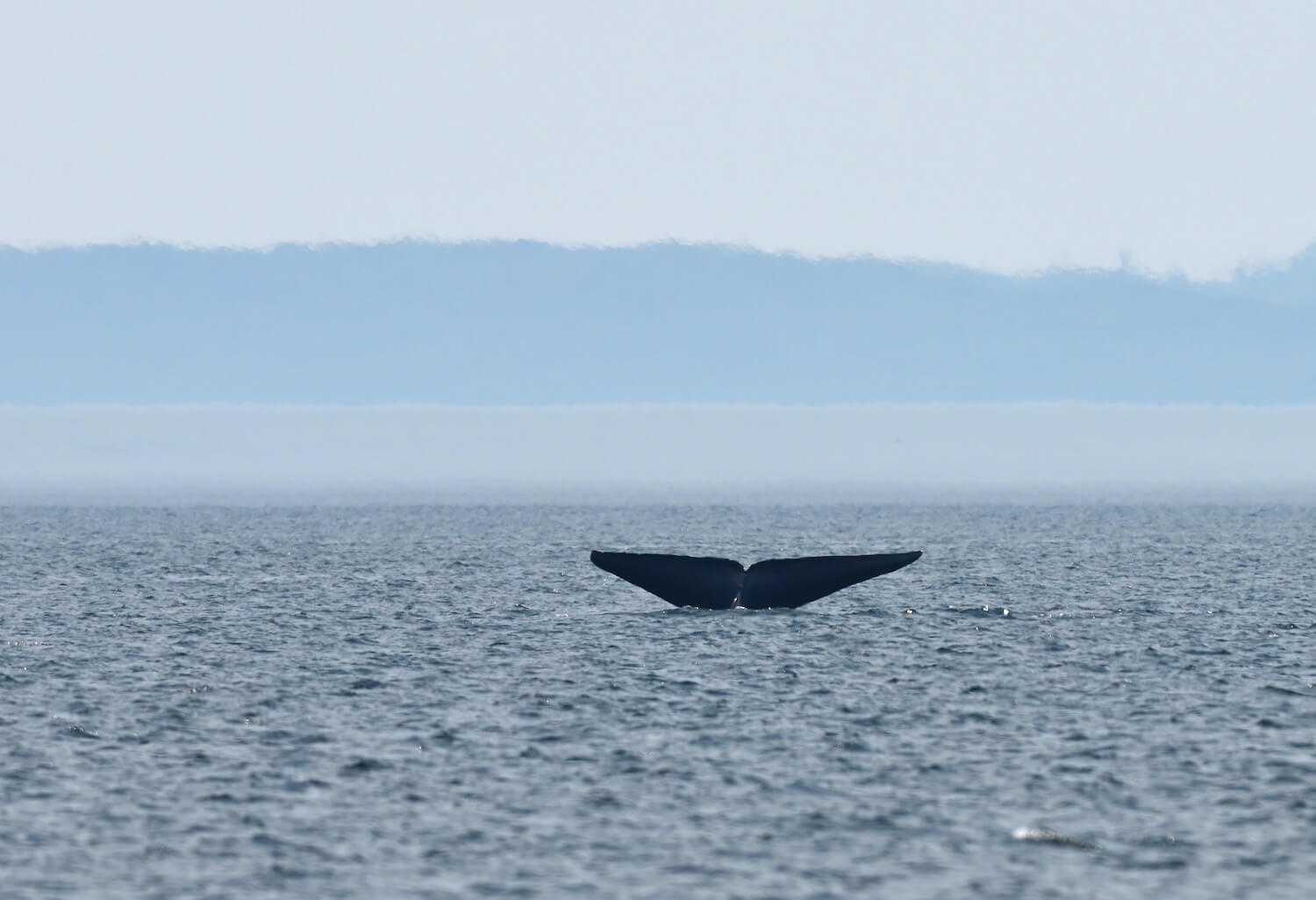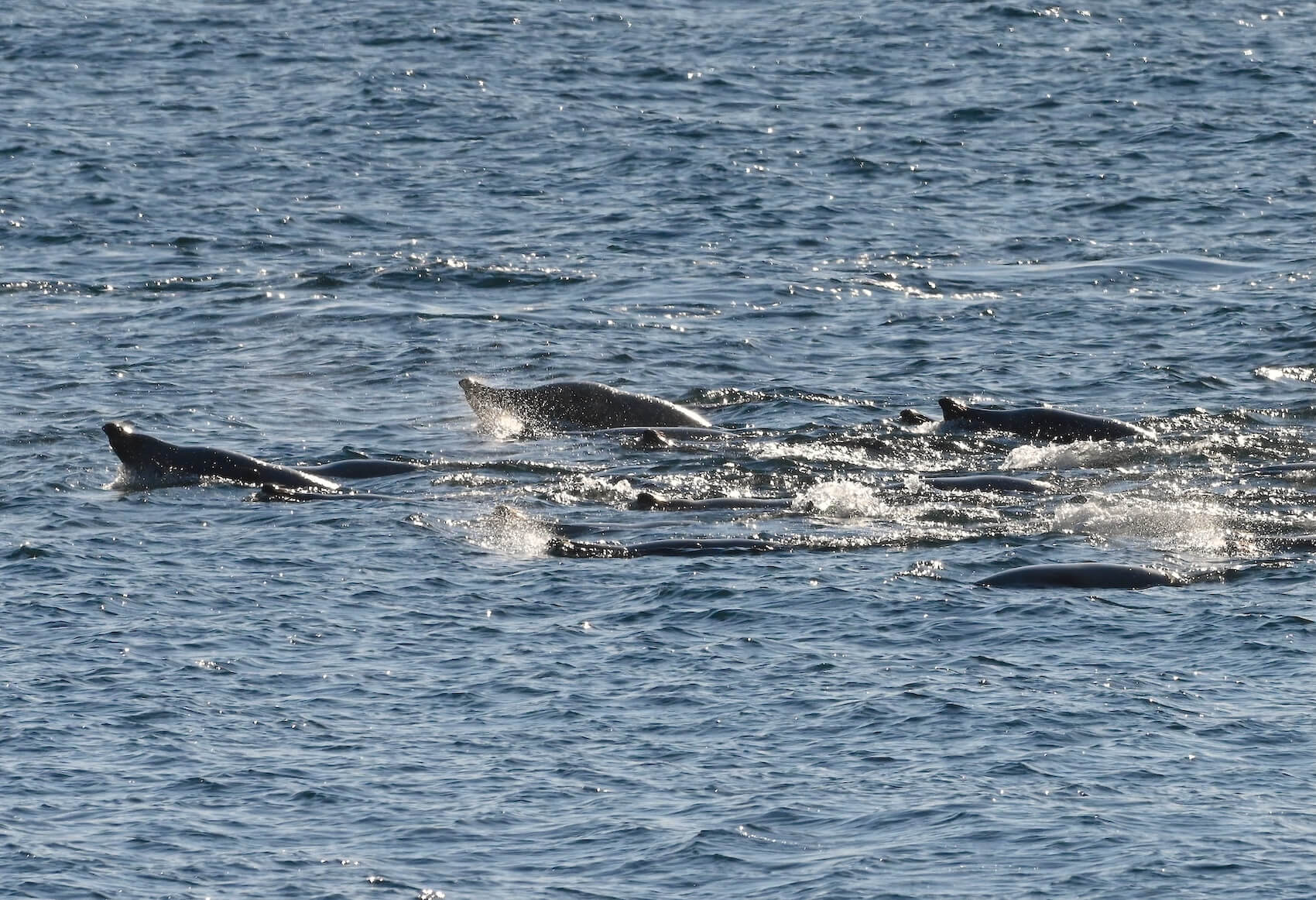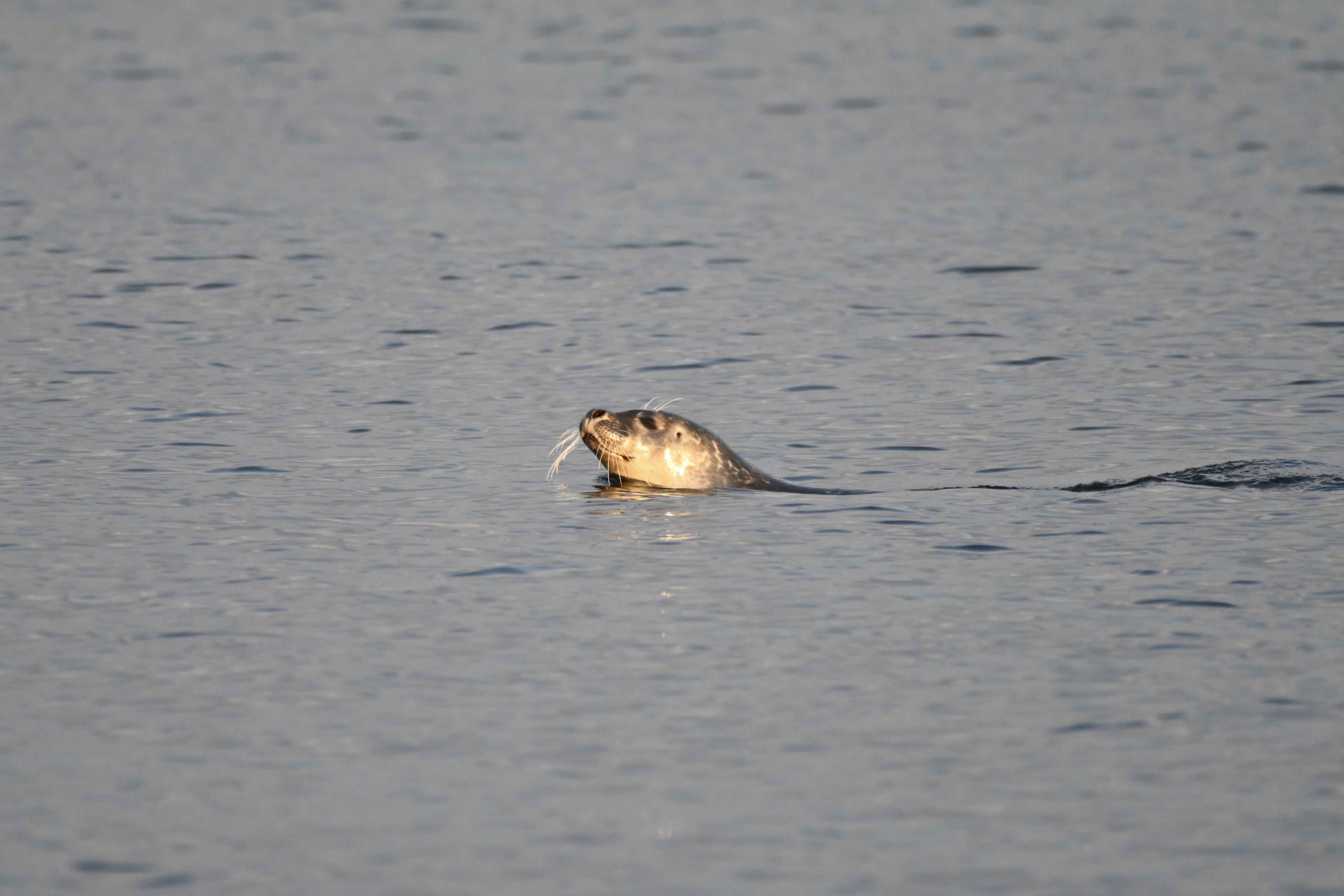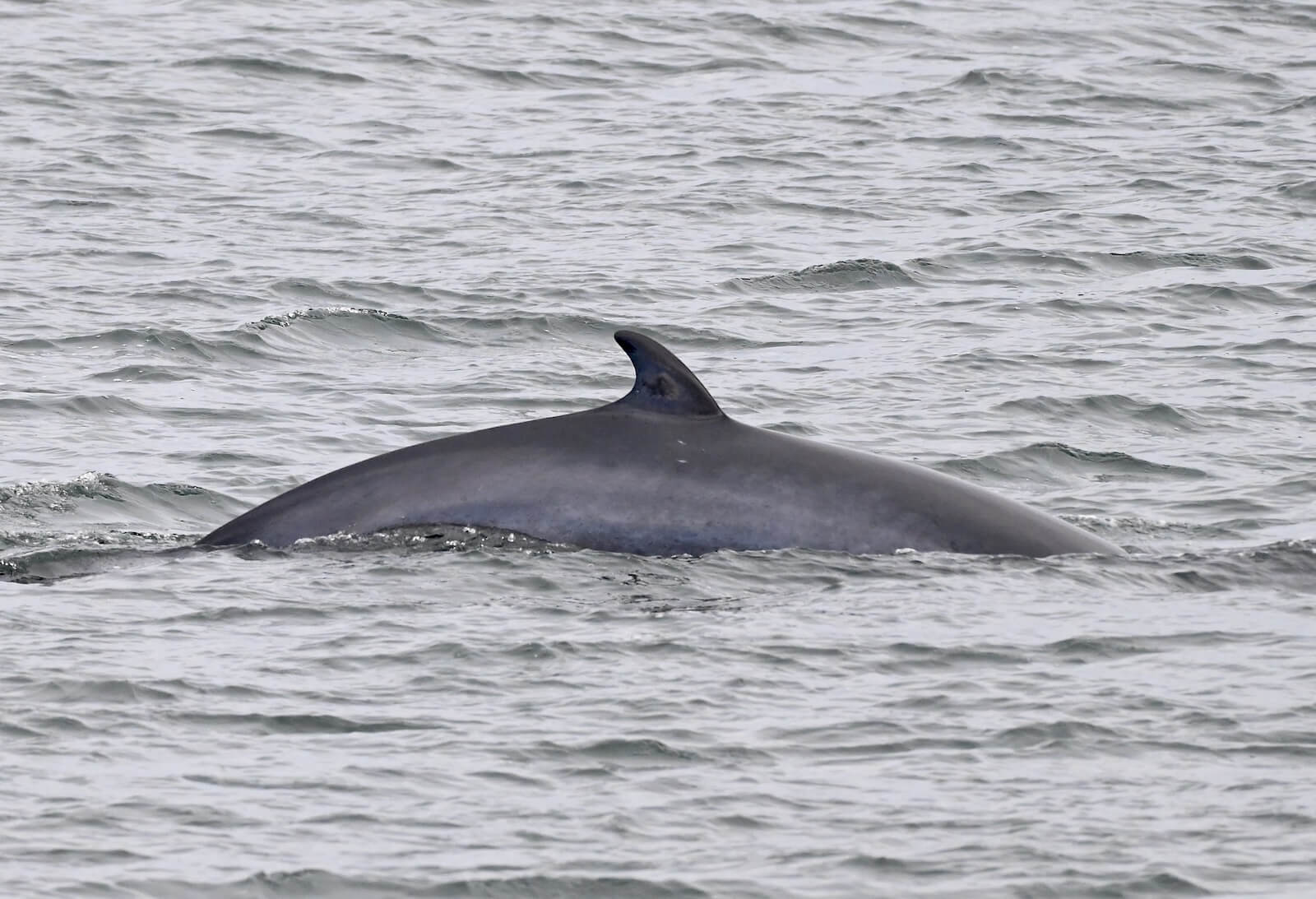Literally and figuratively, whales are a big deal in the St. Lawrence. This week, blue whales B275 (a.k.a. Phoenix) and B197 (a.k.a. Pleiades) were feeding in the estuary, while harbour porpoises, seals, humpbacks, and fin whales were reported all over. Research organizations are also getting in on the action by sharing their most notable observations with us!
A blue giant
Three people visiting Quebec’s Côte-Nord region were particularly lucky in terms of sightings: “In the span of just a few minutes on the water, the blue whale that was showing its tail surfaced to take several breaths and dove three times!” Not all members of this species do this! Only 15 to 18% of blue whales in the St. Lawrence show their tails when they dive. The individual was likely Phoenix, a female blue whale known for such behaviour. The first sighting of Phoenix dates back to 1992, and she has frequently returned to the region ever since. In 2018, she was observed with a calf!
“After deciding to leave her alone, it wasn’t long before we heard the powerful blast of a fin whale. And as we were returning along the coast, not one but two different humpbacks showed their backs and tails!”
A few anecdotes from the sea
Sitting at the village marina one early morning, a Tadoussac resident heard a minke whale blow about ten times while the horizon was still shrouded in mist. Also in the area, a seal “was breathing so heavily you’d think it had sinusitis.” When the fog is too heavy, animals can be detected simply by listening.
In a less relaxing but equally healthy setting, one runner found a good excuse to make a stop: “Saturday morning, I spotted a lone grey seal at the end of the ferry dock in Les Escoumins while I was out for a jog. It gave me a good excuse to take a breather.”
A family from Charlevoix made one of their regular visits to the docks in Port-au-Persil. “This time, not just belugas, but two small porpoises […] diving in perfect unison.” The harbour porpoise’s swimming is very fast and dynamic. It looks as if it’s rolling across the water surface!
Stars aligned
A wildlife photographer was able to capture surface feeding scenes of the blue whale Pleiades. “The stars were definitely aligned, as this individual […] suddenly decided to feed near the surface. It rolled onto its side with its pectoral fin in the air, constantly changing direction, twisting its whole body to engulf its food near a tide rip.”
“Thursday, July 31: At 6:00 this morning in Les Bergeronnes, 10 to 15 small porpoises, including juveniles, swimming at a good clip. Two or three grey seals and a few harbour seals (at least two that were close together), as well as large belugas in the distance. We could clearly see and hear them blow because there was no wind. Some of them even showed their tails!”
On the other side of the St. Lawrence, in Gaspé Bay, one naturalist reported a whole array of animals: “This week, there were quite a few minke whales and porpoises.” Two humpbacks have been cruising the area, sometimes exhibiting impressive behaviours. “Awesome displays with their pectoral fins and even tail slapping. Fin whales have also been observed on occasion. In any case, it’s been a terrific whale-watching season on the tip of the Gaspé!” Grey seal numbers are on the rise at Cap Gaspé.”
Action for research organizations
Research organizations are humming with projects, and the season is already in full swing! The Mériscope team spotted two minke whales feeding near the Tadoussac marina. A third individual was near the mouth of the Saguenay Fjord. “None of them could be identified,” explains one crew member, “due to the lack of distinctive markings.” On the way back, the team encountered a fin whale. The Mingan Island Cetacean Study observed eight minke whales and a fin whale near Anticosti Island, as well as a North Atlantic right whale. An assistant from the Group for Research and Education on Marine Mammals shared a memorable moment. They saw a very young beluga calf at Cap de la Tête au Chien. “It was full of fetal folds and its tail still looked soft. It wasn’t swimming very well yet either. It was accompanied by a white adult and a grey juvenile. We can’t say how old it was, but it was quite young!” This endangered population is estimated to number around 1,850 individuals, which is why each calf represents a glimmer of hope for the species’ recovery.
Where are the whales this week? Sightings map
These data were reported by our network of observers. They give an idea of the presence of whales and in no way represent the actual distribution of whales in the St. Lawrence. Just for fun!
Click on the whale or seal icons to discover the species, the number of individuals, additional information or photos of the sighting. To enlarge the map, click on the icon in the top right-hand corner. The map works well on Chrome and Firefox, but not so well on Safari.
To display the list of sightings, click on the icon in the top left-hand corner.
Thanks to all our collaborators!
Special thanks go out to all our observers who share their love for marine mammals with us! Your encounters with cetaceans and pinnipeds are always a pleasure to read and discover.
On the water or from shore, it is your eyes that give life to this column.
Odélie Brouillette
Marie-Andrée Charlebois
Guylaine Côté
Thalia Cohen-Bacry
Laetitia Desbordes
Benjamin Gagné
Hélène Guitton
Audrey Leblanc
Sven Meier
Camille Némond
Pascal Pitre
Estelle Pagé
Renaud Pintiaux
Diane Ostiguy
Christine Stadelmann
Guy Synnott
Laurence Tremblay
Marielle Vanasse
Patrick Weldon
And all those we left out!
Additionally, we would like to acknowledge the following teams that also share their sightings:
Sept-Îles Research and Education Centre (CERSI)
Group for Research and Education on Marine Mammals (GREMM)
Marine Mammal Observation Network (MMON)
Quebec Marine Mammal Emergency Response Network (QMMERN)
Mingan Island Cetacean Study (MICS)
Mériscope
Would you also like to share your observations?
Have you seen any marine mammals in the St. Lawrence? Whether it’s a spout offshore or just a couple of seals, drop us a line and send your photos to [email protected]!











